Images of Omaha Material Culture
The digital images of selected Omaha material culture seen here and throughout the UNL Omaha Language website were photographed
by Matt Pearson at the UNL Center for Digital Research in the Humanities, or as otherwise noted.
All items included here are from the Awakuni-Swetland family, or as otherwise noted.
The selection of items to be photographed was based upon the desire to share a glimpse of the stunningly beautiful Omaha material
culture world. Many of the objects are replicas of heirloom late 19 th and early 20th century Omaha pieces now housed in museum collections around the world. Objects that are used primarily for ritual purposes
have been intentionally omitted out of respect for the Omaha people.
More images of Omaha material culture can be viewed on-line at the Omaha Indian Heritage Project at the University of Nebraska, including links to other on-line Omaha images from around the world.
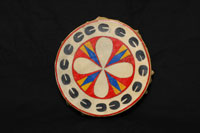
Hand drum.
kúge, or kúge zhinga, or thexe gaku bthaska. kuge 'drum', zhinga 'small', thexe 'kettle', gaku, 'to tap', bthaska 'flat'.
Horse rawhide over wood frame. Watercolor motif derived from Omaha rawhide parfleche designs with buffalo hoof prints around
perimeter. Made for Keali'I Swetland.

Hand drum.
kúge, or kúge zhinga, or thexe gaku bthaska. kuge 'drum', zhinga 'small', thexe 'kettle', gaku, 'to tap', bthaska 'flat'.
Horse rawhide over wood frame. Watercolor motif derived from Omaha rawhide parfleche designs with buffalo hoof prints around
perimeter. Made for Micah Swetland.
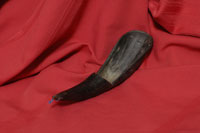
Buffalo horn spoon.
tehe, or tehe sabe. te 'buffalo', he 'horn', sabe 'black'.
Gift of Clara Lawson to the UNL Omaha language class in 2005. Buffalo horn spoons were common throughout the Great Plains.
For certain Omaha clans, the buffalo horns, head meat, and tongue were ritually taboo. In those cases, a carved wooden spoon
would be used when eating.
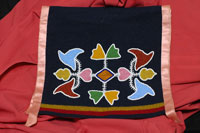
Breechcloth, panel 1.
zhéatigthon.
Two-needle appliqué beadwork on wool with satin ribbon binding. Adapted from an Omaha breechcloth in the collections of the
Phoebe A. Hearst Museum of Anthropology, University of California-Berkeley. Awakuni-Swetland.

Breechcloth, panel 2.
zhéatigthon.
Two-needle appliqué beadwork on wool with satin ribbon binding. Adapted from an Omaha breechcloth in the collections of the
Phoebe A. Hearst Museum of Anthropology, University of California-Berkeley. Awakuni-Swetland.
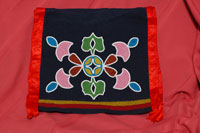
Breechcloth, panel 1.
zhéatigthon.
Two-needle appliqué beadwork on wool with satin ribbon binding. Adapted from an Omaha breechcloth collected by Margaret Mead
on the Omaha Reservation, 1930. In the collections of the American Museum of Natural History, New York. Awakuni-Swetland.
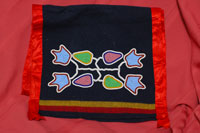
Breechcloth, panel 2.
zhéatigthon.
Two-needle appliqué beadwork on wool with satin ribbon binding. Adapted from an Omaha breechcloth worn by Charlie Wolf at
the Macy, Nebraska Powwow, September 1922. A black and white photograph is in the collections of the Nebraska State Historical
Society. Awakuni-Swetland.
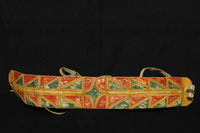
Incised burden strap.
máshakon.
Beef rawhide and watercolor. Adapted from Omaha examples in museum collections. B & K Brewer.
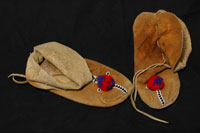
Omaha moccasins.
hinbe or hinbe ukethin. hinbe 'shoe', ukethin 'common'.
Smoked moose leather, beads, yarn. Adapted from Omaha examples in the collections. of collections of the Phoebe A. Hearst
Museum of Anthropology, University of California-Berkeley. Awakuni-Swetland.
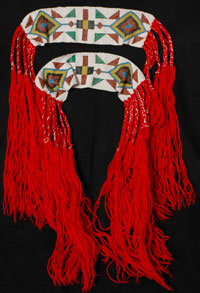
Heddle woven garters.
híthawi.
Glass beads, yarn. Adapted from Omaha garters worn for dances and ceremony, transferred from the collections of the Peabody
Museum to the Omaha Tribe. Awakuni-Swetland.
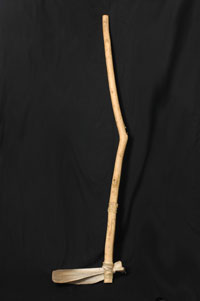
Scapula hoe.
wé?e.
Beef shoulder blade bone, willow handle, rawhide binding. Used by students during the summer 2005 Native American Horticulture
Project (Indian garden) for planting heritage varieties of Indian corn, squash, watermelon, and beans. Awakuni-Swetland.
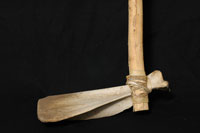
Scapula hoe.
wé?e.
Beef shoulder blade bone, willow handle, rawhide binding. Used by students during the summer 2005 Native American Horticulture
Project (Indian garden) for planting heritage varieties of Indian corn, squash, watermelon, and beans. Awakuni-Swetland.
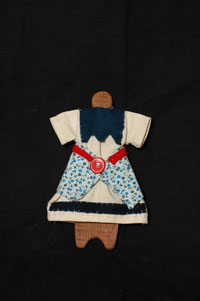
Doll.
shíngazhinga waséson. shinga from nikashi nga 'person', zhinga 'small', shíngazhinga 'baby', waséson 'plaster, clay'.
Cedar shake body, cloth dress. Modeled after an Omaha doll in the collections of th/e Smithsonian Institution. The doll may
represent the work of an Omaha girl attending school at the Presbyterian Mission in the late 19 th century. Girls were taught
American house keeping skills, including sewing. The cut of the clothing appears similar to the clothes worn by the non-Omaha
matrons. Awakuni-Swetland
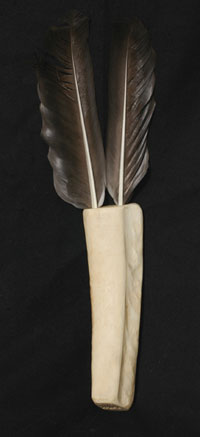
Rib bone slide.
Buffalo rib, domestic goose feathers. A common winter game played on ice or packed snow by Native people throughout the Great
Plains. Awakuni-Swetland.
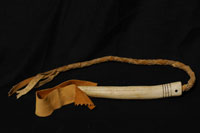
Quirt.
wahí wégasapi. wahí 'bone', wégasapi 'to whip with'.
Elk antler, plaited leather, wood. Adapted from Omaha examples in museum collections. Awakuni-Swetland.
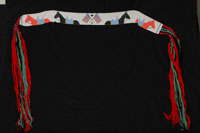
Belt.
hínska ipíthage. hínska 'bead', ipíthage 'belt'.
Beads, linen thread, wool yarn. Adapted from an Omaha belt collected on the Omaha Reservation, circa 1930, and in the collections
of the Chicago Field Museum. The treatment of the horses and flags is reminiscent of examples from the Osage Tribal Museum,
Pawhuska, Oklahoma. Awakuni-Swetland.
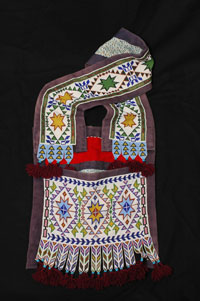
Bandoleer bag.
núsi áxthade úzhiha. úzhi 'to contain', ha 'hide or skin', úzhiha, 'bag'.
Beads, wool and cotton cloth, yarn, linen thread. Adapted from an Omaha example in the collections of the Volkerkunde Museum
in Berlin, Germany. The beadwork is produced using a two-needle method. Awakuni-Swetland.
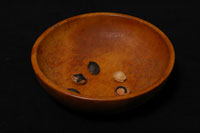
Plum dice.
kónsi or kónsi ge. kónde 'plum', si 'seed', ge 'scattered'.
Wild plum seeds marked with ink, wooden bowl. Adapted from Omaha examples in museum collections. The game was played by women,
often for wagers. Awakuni-Swetland.
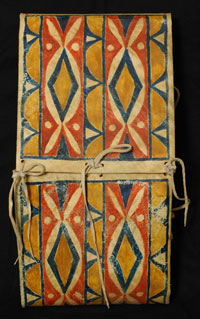
Folded parfleche.
weábastá
Horse rawhide, watercolor, leather ties. Adapted from Omaha examples in museum collections. The expandable container was used
to carry dried foods, medicinal plants, ritual objects, and personal clothing. It was often made in matched pairs for balancing
the load on a horse. B & K Brewer.
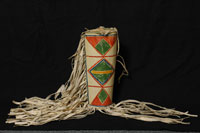
Folded parfleche.
weábastá.
Horse rawhide, watercolor, leather ties. Adapted from examples in museum collections from various Great Plains tribes. The
design is adapted from other Omaha parfleche. The lidded container was often associated with the storage of medicinal plants
and ritual objects. B & K Brewer.
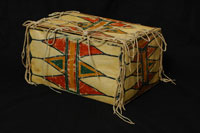
Parfleche trunk.
weábastá
Horse rawhide, watercolor, leather ties. Adapted from a folded trunk attributed to the Omaha in a museum collection. The box
shape may be a native adaptation of Euro-American boxes and trunks available in the early reservation period. B & K Brewer.
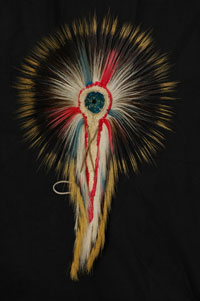
Hair roach.
tahinwagthon. ta from taxti 'deer', hín 'fur or body hair', wagthon 'badge'.
Porcupine guard hair, dyed deer tail hair. Previously a warrior society emblem, now commonly worn by males of all ages. Attached
to the head by threading a small braid of hair through the central hole and an overlaying flat bone/antler hair spreader.
Used by Hollis Dawes Stabler as a youth. This roach was given to Mark Awakuni-Swetland by the father, Hollis Dorion Stabler,
in 2005.
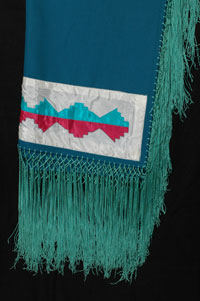
Woman's dance shawl.
waín.
Gabardine wool, fringe, silk ribbon work. A common attire for women entering the dance arena. Worn around the shoulders, or
folded and draped over the right arm. The strip of ribbon work comes from the Osage Tribal Museum, Pawhuska, Oklahoma. It
was added to the cloth. Fringes were embellished with a second row of knots for Donna Awakuni-Swetland.
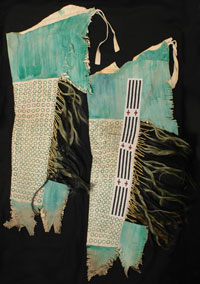
Leggings.
uthón tónga. uthón 'pants', tónga 'big'
Brain-tanned deer hide, horse hair, human hair, water color. Adapted from nearly identical Omaha leggings in the Phoebe A.
Hearst Museum of Anthropology, University of California-Berkeley and the Joslyn Art Museum, Omaha, Nebraska. These are embellished
leggings worn for dances and ceremony. The most notable difference between the two museum examples is in the design on the
beadwork strip. This pair uses the design found on the Joslyn leggings. Awakuni-Swetland.
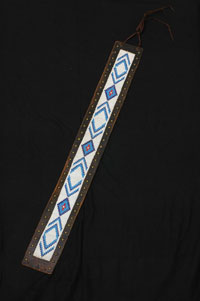
Belt.
hínska ipíthage. hínska 'bead', ipíthage 'belt'.
Beads, leather, cotton thread. A dance belt worn by Charles Stabler, Jr. (1900-1992) and gifted to Hollis Dorion Stabler many
years ago. It was gifted to Mark Awakuni-Swetland in 2004.
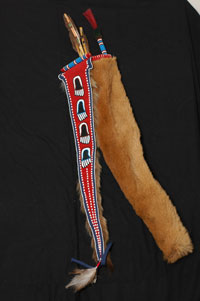
Quiver with arrows.
mónzhiha. món. 'arrow'. zhi from úzhi 'to contain', ha 'hide or skin', úzhiha, 'bag'.
Mountain lion skin, dyed horse hair, wood, beads, wool cloth, mallard duck neck feathers, metal, sinew, turkey feathers. Adapted
from an Omaha quiver in the Phoebe A. Hearst Museum of Anthropology, University of California-Berkeley. This is an embellished
quiver, part of a quiver-bowcase set, that would be worn for dances and ceremony. The bear paw beadwork design is derived
from the beaded strips on an Omaha big shirt in the Volkerkunde Museum, Berlin, Germany. The straightening rods are beaded
using concentric rings as seen on the Berkeley example. Awakuni-Swetland.
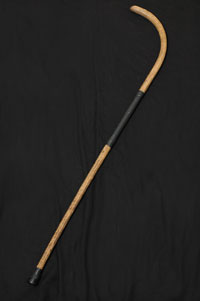
Shinny stick.
tabé gasi zhon.. Shinny is called: tabé gasi. tabé 'ball', gasi, '', zhon 'stick or wood'.
Wood, plastic tape, rubber. This shinny stick, possibly made from hickory, was crafted by Tom C. Walker circa 1940. He used
it to play shinny on the Omaha reservation. A game similar to field hockey, two teams of men would attempt to drive a flattened
circular ball through goal posts on opposite ends of a freshly cut hay meadow. After retiring from the game, Tom C. converted
the shinny stick into a cane in his later years. He gifted this shinny stick to Mark Awakuni-Swetland in 1994.

Gourd dance blanket.
péxe wachígaxe waín. péxe 'gourd', wachígaxe 'dance', waín 'blanket'.
Wool cloth, cotton binding, various medals. Worn by members of the Omaha Tia-Piah Society, a southern plains veteran's dance
that was gifted to the Omaha people in the late 1960s from the Kiowa. Veterans often display their combat pins and other medals
on the blanket. Initiated into the Omaha Tia-Piah Society in 1973, Awakuni-Swetland displays various academic medals and honors
on the blanket.
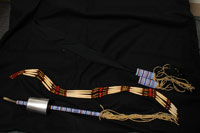
Gourd dance rattle, sash, and bandoleer.
péxe, ipíthage, núsi áxthade. péxe 'gourd rattle, or mónze pexe 'metal gourd rattle', ipíthage, 'belt', núsi áxthade 'bandoleer'.
Metal rattle with wooden plug, fiberglass rod covered with leather and beadwork. Cloth sash and fringes with beadwork over
plastic cylinders. Bone hairpipe, composite beads, leather, metal studs, and imitation sinew lacing. The metal rattles used
by the gourd dancers simulates the small arms fire that could be heard at a distance during a battle with federal troops.
The combination of bandoleer and decorated sash replicate the saber or side-arms support captured from defeated cavalry troops.
Awakuni-Swetland.
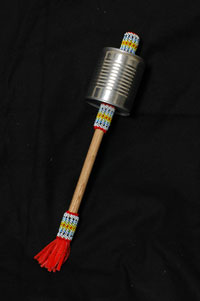
Gourd dance rattle.
péxe. péxe 'gourd rattle, or mó nze pexe 'metal gourd rattle'.
Tin can, wood rod covered with leather and beadwork. The metal rattles used by the gourd dancers simulates the small arms
fire that could be heard at a distance during a battle with federal troops. Many times the rattles were fashioned from the
baking powder cans issued as rations to Indians in the late 19 th century. Awakuni-Swetland.
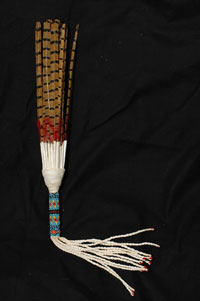
Fan.
Pheasant feathers, glass beads, leather, paint. A fan used during gourd dances and other occasions. Originally made by Clyde
Sleeper, Sr. and later gifted to Mark Awakuni-Swetland in the late 1970s.
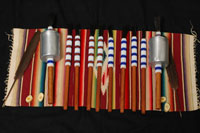
Hand game set.
ínuthin. in from íne 'stone', uthín 'to strike'.
Wood, leather, beads, nylon thread, deer leg bone "stones", aluminum salt shaker rattles, turkey feathers. Hand game involves
participants hiding small stones, shells, or pieces of bone and challenging the opposing side to guess which combination of
hands the stones are in. Score keepers watch the counter sticks and shake the rattle when one team has succeeded in winning
all eight sticks. Two people from the losing side are given the rattles to dance with, and present a small gift back to the
sponsors as penalty for losing. Teams play for a wager. While being a fast-paced social activity, there are traditional protocols
and ritual observances. This set was created by Mark Awakuni-Swetland for use by the Macy Public School students in their
Indian Culture Program in the late 1980s. The materials were chosen to withstand any accidental rough handling by the young
players. The counter sticks are beaded using concentric rings as seen on a quiver straightening rod in the collections of
the Phoebe A. Hearst Museum of Anthropology, University of California-Berkeley.
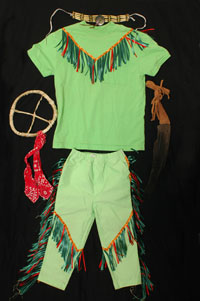
Grass dance regalia.
Cloth and ribbons, goose wing fan, rawhide covered willow hoop. This is a portion of a beginner's grass dance regalia crafted
by Donna and Mark Awakuni-Swetland for their son, Keali'I Swetland, when he started dancing in 2005. The movement of the grass
dancer reflects the motion of the winds across the grassy plains. The rawhide-covered willow hoop is part of the hoop and
pole game, and represents the name of the I nkesabe (Black Shoulder Buffalo clan) Wathigizhe sub clan to which Keali'I belongs.
Keali'I chose the colors.
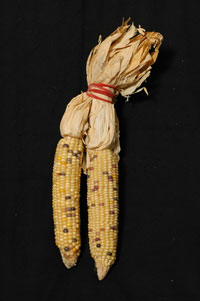 Indian corn.
Indian corn.
wahába ska. wahába 'an ear of corn', ska 'white'.
A white mixed variety grown by Winnebago and Omaha horticulturalists.
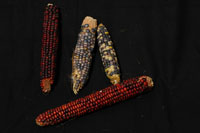
Indian corn.
wahába zhíde. wahába 'an ear of corn', zhíde 'red'.
A red-mixed variety grown by Kickapoo horticulturalists near McLoud, Oklahoma. Gifted to Micah Swetland by Albert Sanderson.
Used by students during the summer 2005 Native American Horticulture Project (Indian garden). Awakuni-Swetland.



































